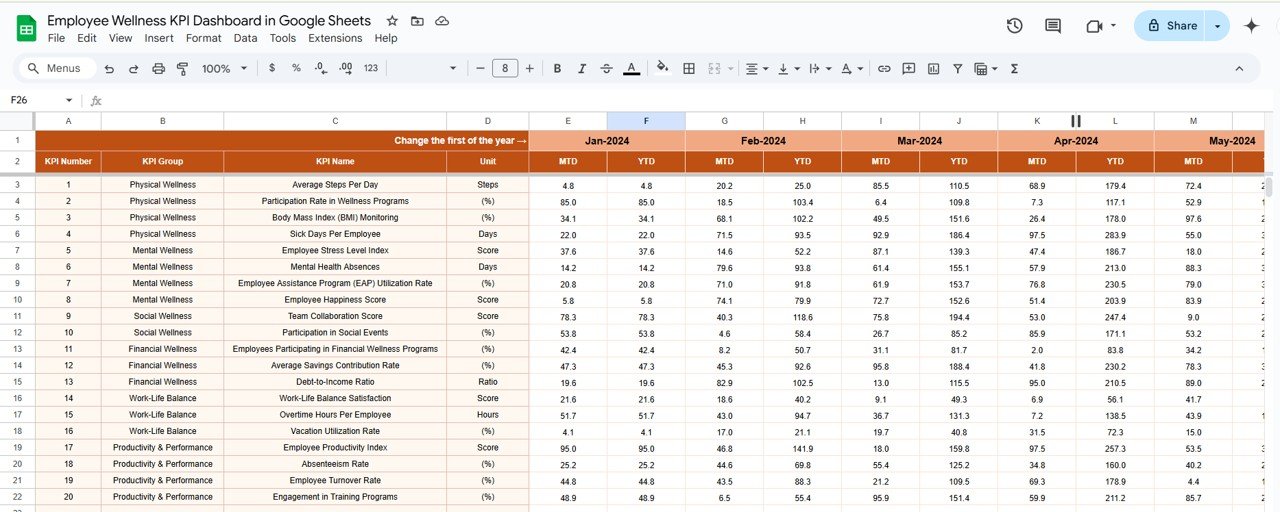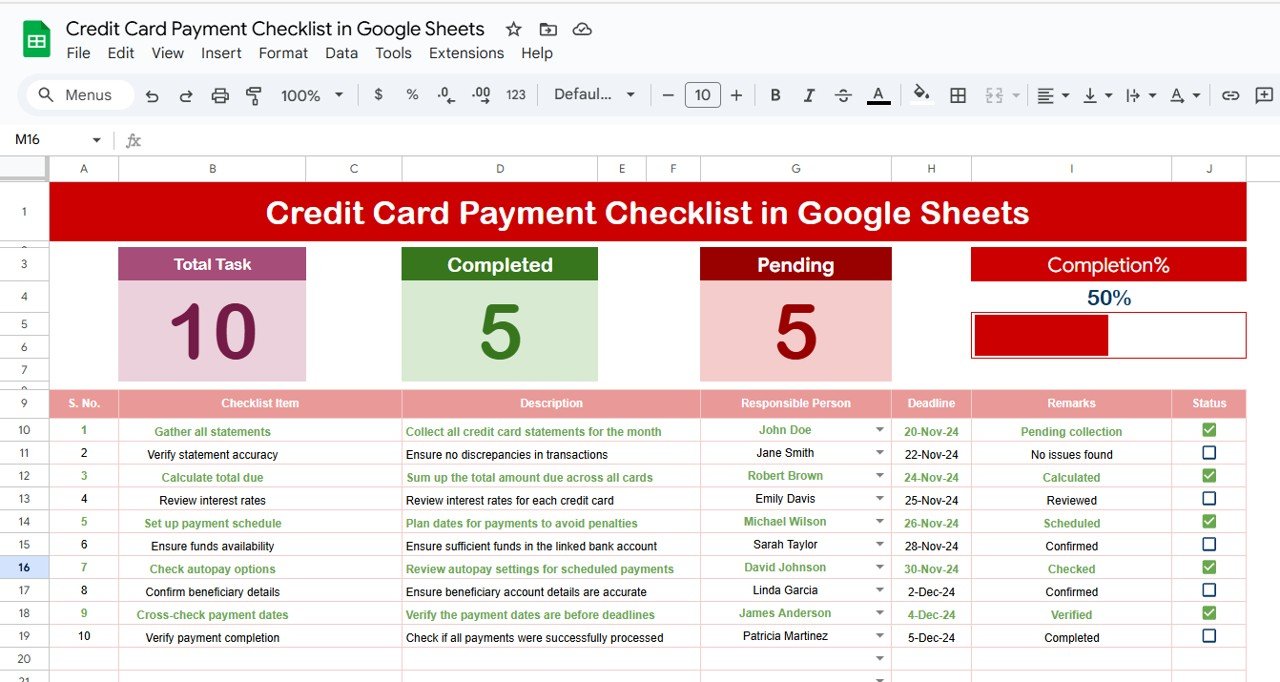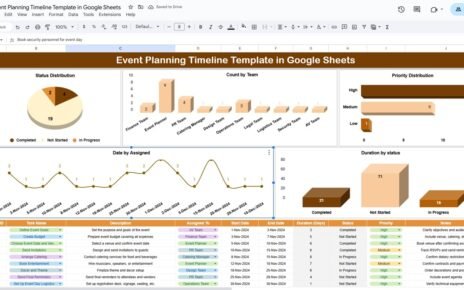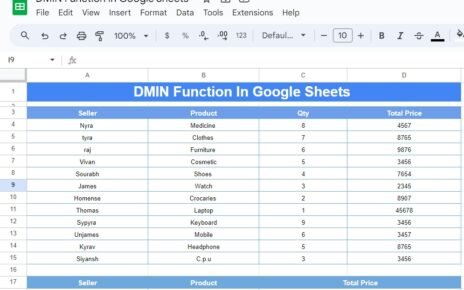Employee wellness is a critical aspect of any organization, influencing productivity, job satisfaction, and overall company culture. Tracking employee wellness metrics helps businesses monitor the well-being of their workforce and make data-driven decisions to improve health and engagement. One of the most efficient ways to track employee wellness is through a KPI Dashboard in Google Sheets.
In this article, we will explore how to set up an Employee Wellness KPI Dashboard in Google Sheets, which is a ready-to-use template designed to help businesses measure and enhance their employees’ wellness. We’ll also look at the key features, the KPIs to track, and how to customize the dashboard to suit your organization’s needs.
Table of Contents
ToggleIntroduction to Employee Wellness KPIs
Employee Wellness KPIs are metrics used to measure the physical, mental, and emotional well-being of employees within an organization. These KPIs provide insights into various wellness aspects such as work-life balance, stress levels, physical health, mental health, and overall job satisfaction.
By tracking these KPIs, organizations can identify areas that require improvement, create wellness programs, and enhance employee satisfaction. A Google Sheets KPI Dashboard makes it easy to track these metrics and visualize the data, helping business leaders make informed decisions.
Key Features of the Employee Wellness KPI Dashboard
Click to buy Employee Wellness KPI Dashboard in Google Sheets
The Employee Wellness KPI Dashboard in Google Sheets is designed to be simple, effective, and customizable. It consists of six essential worksheets, each serving a unique purpose to track and analyze wellness metrics. Below are the key features of the dashboard:
1. Dashboard Sheet Tab
This is the main sheet of the Employee Wellness KPI Dashboard, where you can view an overview of all the key wellness KPIs.
Key Features:
- Month Selector: Use a dropdown (Range D3) to select the month, and the dashboard will automatically update with data for the selected month.
- MTD and YTD Data: Displays Month-to-Date (MTD) and Year-to-Date (YTD) actual numbers, target values, and previous year data.
- Performance Comparisons: Shows Target vs Actual and Previous Year vs Actual comparisons, with conditional formatting to highlight performance using up/down arrows.

Click to buy Employee Wellness KPI Dashboard in Google Sheets
2. KPI Trend Sheet Tab
This sheet allows you to track the trend of each KPI over time.
Key Features:
- KPI Selection: You can select any KPI from the dropdown (Range C3), and the sheet will display relevant information.
- KPI Data: For each KPI, the dashboard shows the KPI Group, Unit, Formula, Definition, and whether the KPI is a Lower the Better or Upper the Better metric.

3. Actual Numbers Sheet Tab
Here, you enter the actual numbers for the MTD and YTD data for a particular month. The data entered will be reflected in the Dashboard.
Key Features:
- Month Selector: Select the first month of the year from Range E1, and input the data for each KPI.
- Manual Data Entry: Enter the actual wellness data (such as physical activity levels, employee satisfaction scores, etc.) for the selected month.

Click to buy Employee Wellness KPI Dashboard in Google Sheets
4. Target Sheet Tab
In this sheet, you will input the target values for each KPI for both MTD and YTD.
Key Features:
- Target Values: Enter the target numbers for each KPI to compare actual performance.
- MTD and YTD: You can enter targets for each month (MTD) and for the entire year (YTD).

5. Previous Year Numbers Sheet Tab
This sheet stores data from the previous year for comparison with the current year’s performance.
Key Features:
- Historical Data: Enter the previous year’s data for each KPI.
- Comparative Analysis: The dashboard compares the current year’s wellness data with that of the previous year.

Click to buy Employee Wellness KPI Dashboard in Google Sheets
6. KPI Definition Sheet Tab
In this sheet, you can define each KPI in terms of its name, group, unit, formula, and definition.
Key Features:
- KPI Information: Enter the necessary details about each KPI to ensure clarity and consistency across the dashboard.

Advantages of Using an Employee Wellness KPI Dashboard
The Employee Wellness KPI Dashboard in Google Sheets offers several benefits to organizations looking to improve employee well-being:
- Centralized Data: All wellness metrics are consolidated into one dashboard, making it easy to access and monitor performance.
- Real-Time Tracking: The dashboard automatically updates as you enter new data, ensuring that you always have the latest insights into employee wellness.
- Data Visualization; With graphs, conditional formatting, and clear comparisons (MTD vs YTD, Target vs Actual), the dashboard offers an intuitive visualization of wellness metrics.
- Improved Decision-Making; By tracking wellness metrics, businesses can identify areas needing improvement and make data-driven decisions to enhance employee engagement.
- Customizable Metrics: You can adjust the KPIs according to the specific needs of your organization, tracking the aspects of wellness that matter most.
Opportunities for Improvement in Employee Wellness KPIs
Click to buy Employee Wellness KPI Dashboard in Google Sheets
Though the Employee Wellness KPI Dashboard is a powerful tool, there are still opportunities for improvement:
- Integration with Other Wellness Platforms: Currently, data must be entered manually. Integrating the dashboard with wellness apps or HR platforms could automate data collection and save time.
- Advanced Analytics: Incorporating advanced analytics, such as predictive modeling or sentiment analysis, could provide deeper insights into employee wellness trends and issues.
- Interactive Features; Adding interactive features, such as drill-down capabilities and dynamic graphs, could make the dashboard more user-friendly and allow for more detailed analysis.
Best Practices for Creating and Using the Employee Wellness KPI Dashboard
To make the most out of the Employee Wellness KPI Dashboard, here are some best practices:
- Select Relevant KPIs; Choose KPIs that are meaningful and align with your company’s wellness objectives, such as employee satisfaction, absenteeism rate, or physical activity levels.
- Update the Dashboard Regularly: To ensure accuracy, update the dashboard regularly with the latest data. Monthly updates allow you to track trends and make timely adjustments.
- Use Conditional Formatting Effectively; Use conditional formatting to highlight areas of concern. For example, a red arrow can indicate underperformance, while a green arrow can show positive results.
- Share Insights with Stakeholders; Ensure that key stakeholders (HR managers, team leaders, etc.) have access to the dashboard so they can take action based on the data.
Frequently Asked Questions (FAQs)
Click to buy Employee Wellness KPI Dashboard in Google Sheets
What are Employee Wellness KPIs?
Employee Wellness KPIs are metrics used to track the physical, mental, and emotional health of employees. These KPIs help organizations monitor how well employees are performing in terms of their well-being and identify areas that need improvement.
How does an Employee Wellness KPI Dashboard help improve employee engagement?
By monitoring wellness data, businesses can quickly identify and address employee well-being issues. This proactive approach can increase job satisfaction, reduce absenteeism, and improve overall employee engagement.
Can I customize the KPIs in the Google Sheets Dashboard?
Yes, the dashboard can be customized to include KPIs specific to your organization’s wellness program. You can add or modify KPIs as needed.
How do I update the dashboard for each month?
Simply select the month from the dropdown in Range D3, and input the latest data in the Actual Numbers, Target, and Previous Year Numbers sheets.
What KPIs should be tracked in an Employee Wellness Dashboard?
Common KPIs include employee satisfaction, absenteeism rate, physical activity levels, mental health scores, work-life balance, and stress levels.
Conclusion
The Employee Wellness KPI Dashboard in Google Sheets is an essential tool for organizations looking to improve employee engagement, reduce absenteeism, and enhance overall well-being. With its easy-to-use design, real-time tracking, and customizable features, this dashboard provides valuable insights into the wellness of your workforce. By following the best practices and regularly updating your data, you can ensure that your wellness programs are effective and continuously improving.
Visit our YouTube channel to learn step-by-step video tutorials
Youtube.com/@NeotechNavigators
Watch the step-by-step video Demo:



